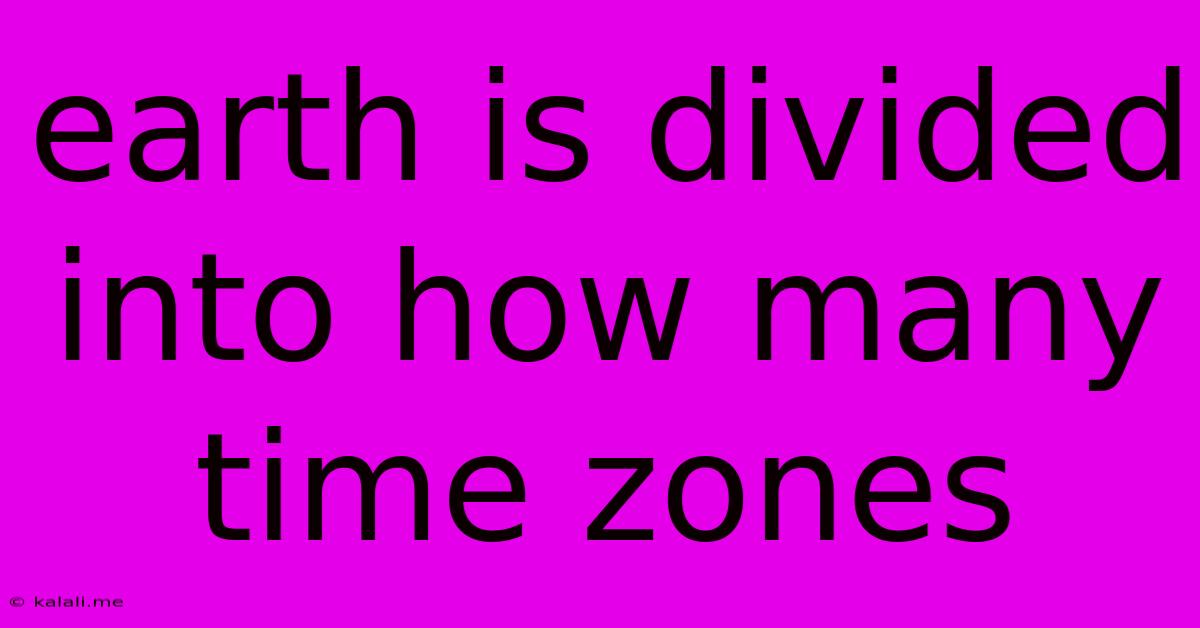Earth Is Divided Into How Many Time Zones
Kalali
Jun 13, 2025 · 3 min read

Table of Contents
Earth is Divided into How Many Time Zones? A Comprehensive Guide
The Earth is divided into 24 time zones, one for each hour of the day. This system, essential for global coordination and communication, helps standardize time across the planet. But the story behind these time zones is far more complex than simply dividing 360 degrees of longitude by 24. This article delves into the intricacies of time zones, exploring their creation, variations, and ongoing relevance in our increasingly interconnected world.
This seemingly simple answer—24 time zones—belies a fascinating system that considers geographical boundaries, political considerations, and even the desire for convenient timekeeping within specific regions. Let's explore the factors influencing this seemingly straightforward global division.
The Prime Meridian and the Birth of Time Zones
The foundation of the global time zone system lies in the Prime Meridian, the line of longitude designated as 0°. Running through Greenwich, England, this meridian serves as the reference point from which all other longitudes are measured—eastward and westward. Each time zone is roughly 15 degrees of longitude wide (360 degrees / 24 time zones = 15 degrees per zone).
Why Not Perfectly 15 Degrees? The Irregularities of Time Zones
While the ideal width of a time zone is 15 degrees, the reality is far more nuanced. Political and geographical boundaries often dictate the actual boundaries of time zones. Countries and regions often adjust their time zones to align with neighboring regions or to suit their internal logistical needs, leading to irregular zone shapes and sizes. This is why you'll find some time zones that are wider or narrower than the standard 15 degrees.
- Political Boundaries: National borders frequently override the ideal longitudinal division, leading to adjustments in time zone boundaries to keep entire countries within the same time zone.
- Geographical Features: Mountain ranges and large bodies of water can also influence time zone boundaries, creating irregularly shaped zones.
- Daylight Saving Time (DST): The practice of shifting clocks forward and backward by an hour during different seasons further complicates the precise location of time zones.
Beyond the 24: Time Zone Anomalies and Exceptions
The seemingly simple 24-time zone system is actually riddled with exceptions and anomalies. Consider these factors:
- International Date Line: Located roughly along the 180° meridian, this line marks the point where a new calendar day begins. Crossing the International Date Line eastward means losing a day, while crossing westward means gaining a day.
- Multiple Time Zones Within a Single Country: Many large countries, such as the United States, China, and Russia, span multiple time zones due to their vast geographical extent.
- Half-Hour and Quarter-Hour Time Zones: Some countries utilize time zones that are offset by half an hour or even a quarter hour from the standard hour increments. This is often seen in regions seeking to optimize daylight hours or align with neighboring countries.
The Ongoing Relevance of Time Zones in a Globalized World
In our interconnected world, the time zone system remains crucial for international travel, scheduling, and communication. Accurate timekeeping ensures smooth international trade, coordinated global events, and the efficient operation of global businesses.
In conclusion, while the Earth is conceptually divided into 24 time zones based on a 15-degree longitude system, the practical application of time zones is much more intricate. Political borders, geographical features, and daylight saving time contribute to a complex and often irregular global timekeeping system. Despite its complexities, the 24-time zone system remains an essential tool for coordinating activities across our planet.
Latest Posts
Latest Posts
-
Act Requirements For Missouri State University
Jun 14, 2025
-
What Is The Bodys Natural Anticoagulant
Jun 14, 2025
-
Area Of The Region Bounded By The Curves Calculator
Jun 14, 2025
-
Difference Between Keratinized And Non Keratinized Epithelium
Jun 14, 2025
-
A Hard Disk Drive Is An Example Of Magnetic Storage
Jun 14, 2025
Related Post
Thank you for visiting our website which covers about Earth Is Divided Into How Many Time Zones . We hope the information provided has been useful to you. Feel free to contact us if you have any questions or need further assistance. See you next time and don't miss to bookmark.